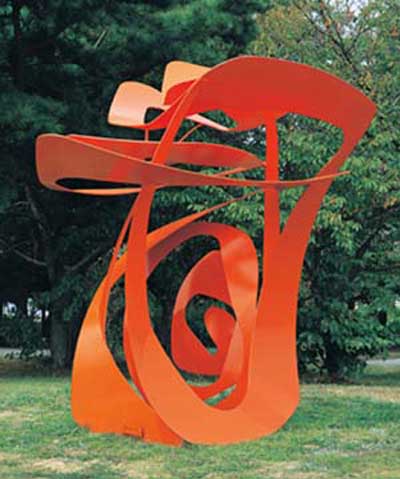
 Sculpture News at SculptSite.com
Sculpture News at SculptSite.com
Phyllis Baker Hammond Receives Sculpture Award |
| East Hampton - Springs sculptor Phyllis Baker Hammond has won a cash award for her work in creating a dazzling orange enameled 10-foot steel sculpture in Japan's Ube Tokiwa Museum's International Biennale sculpture competition. The "Museum of Greenery, Flowers and Sculpture Prize" was presented in Ube in October 2009, and the sculpture is on display at the museum until 2011.
Hammond, a well-known artist in the Hamptons, is past president of the Artists Alliance in East Hampton. "The honor of being selected for the prizes actually came in two parts," Hammond said. She initially submitted a 15-inch high model of the sculpture. Hammond was chosen as one of 20 finalists who were granted funds to travel to Japan to construct full sized sculptures. The sculpture that won the award is similar to many other sculptures Hammond has made in the last few years. She works with large flat panels of metal cut-outs that are conceived in ordinary playful experimental curvy doodles drawn on paper. They are then scanned into a computer and refined using a special graphics program. The subsequent defined forms are cut out on a water jet machine that mixes sand with water to cut the material for a precise refined-edged result. The positive cutouts (or the pieces that are actually cut out, like the one that was awarded the prize) are, with hammer and anvil, twisted, bent, folded and wielded together to create a flow of images in three-dimensional space. Then they are powder-coated with brightly colored paint. The "negative" cutouts, left in full sized sheets, are developed as sculptured wall constructions. Hammond developed the technique when she was teaching, but it also evolved from her past experience working with clay, and wax used for casting in bronze. Using the grant money, Hammond traveled to Japan to create the sculpture. It took a skilled steel craftsman about a month to complete. Hammond's background as a sculptor began in stoneware clay. "My past with clay informs my sculpture," she said. "I focused on mastery of the potter's wheel, spontaneity with clay, and produced abstracts studies of shapes, spaces and containers. My labyrinth of past insights has led to limitless artistic innovations." "In my early studies at Kyoto College in Japan, I learned the value of embracing the unexpected, to hope for the unimagined, and to be experimentally playful - to respect work that happens not because it is planned, but in spite of your plans. The serious work begins when the original work needs to become the 10-foot sculpture." Hammond was born in Elizabeth, NJ and grew up in Melrose, MA, a northern suburb of Boston. She began her venture into the art world at the age of nine when she was awarded a scholarship to drawing classes at the Boston Museum of Fine Arts. The classroom featured large plaster reproductions of Roman sculptures of gods and goddesses. The sculptures made an impression on the young artist and, in her 20s, led to her work with pottery and ceramics. Her later techniques with clay included sculptures with faces in the folds of clay and later she made similar images and sculptures with a special polyester resin wax, which was cast in bronze. Hammond later returned to the School of the Boston Museum of Fine Arts where she graduated with a four-year diploma and a fifth year graduate certificate. After a traveling scholarship from the museum took her to Japan in 1960, Hammond later received a B.S. in Education from Tufts University in 1964. Eventually Hammond moved to New York City, Westchester and then on to East Hampton in 1985, where she currently has a studio and sculpture garden. Hammond has worked as an instructor in the Summerfest Sag Harbor Program and as an adjunct associate professor at a number of schools. She has earned other awards and achievements in her lifetime, including creating the Shakespeare Theatre's "Will Award" presented annually to outstanding actors for classical theatre. Other honors include being a University of Florida at Pensacola finalist for a sculpture garden; fellowships from the Haystack in Deer Island Maine and Ragdale Artists Community, Lake Forest, IL; a Certificate of Outstanding Achievement from Woman in Design International Compendium; and a grant from the National Endowment for the Arts. Public art commissions in the United State include two large bronze sculptures for Connecticut Commission for the Arts, Hartford, at the American Savings Bank, corporate headquarters, White Plains, NY; law offices in Washington DC; Atrium at Centerpoint Office Complex, Fair Oaks, VA, Cadillac Fairwell Corp. headquarters, White Plains, NY; three bronzes at Guest Quarters Hotel in Bethesda, MD; and a clay wall at Unitarian Fellowship in Mt. Kisco. The Ube Tokiwa Museum was opened in 1961 in an effort to help the city with an urban renewal program that started in the aftermath of World War II. The city was devastated by the war. The urban renewal program brought in landscaping and horticultural programs. The objective of the open air museum remains "a wide call to sculptures to create new works." To encourage this, the museum in 1963 began a biennial competition, open to all artists, regardless of backgrounds and experience. The emphasis in the competition was on what is new and exciting in the world of sculpture in any category, from abstract expressionism to realism. |
 "Redefining Space" |
More Sculpture News ....
Submit your SCULPTURE NEWS.
It's easy, just send us an e-mail
(click on Submit News in the left menu) with your pertinent information along with images, we'll take care of the rest. Sculpture makes our world a much better place in so many ways!
SculptSite.com, along with Sculptors and their creative genius all helping to bring the beauty and message of Sculpture to a hurried world.

